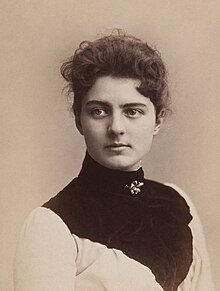
Back فرانسيس كليفلاند Arabic فرانسيس كليفلاند ARZ Frances Cleveland AST Frensis Klivlend Azerbaijani Фрэнсіс Кліўленд Byelorussian Frances Folsom BS Frances Clevelandová Czech Frances Cleveland German Frances Cleveland Spanish Frances Folsom Cleveland Preston Basque
Frances Cleveland | |
|---|---|
 Cleveland c.1886 | |
| First Lady of the United States | |
| In role March 4, 1893 – March 4, 1897 | |
| President | Grover Cleveland |
| Preceded by | Mary Harrison McKee (acting) |
| Succeeded by | Ida Saxton McKinley |
| In role June 2, 1886 – March 4, 1889 | |
| President | Grover Cleveland |
| Preceded by | Rose Cleveland (acting) |
| Succeeded by | Caroline Harrison |
| Personal details | |
| Born | Frances Clara Folsom July 21, 1864 Buffalo, New York, U.S. |
| Died | October 29, 1947 (aged 83) Baltimore, Maryland, U.S. |
| Resting place | Princeton Cemetery |
| Political party | Democratic |
| Spouses | |
| Children | |
| Education | Wells College (BA) |
| Signature | |
Frances Clara Cleveland Preston (née Folsom, christened Frank Clara; July 21, 1864 – October 29, 1947) was the first lady of the United States from 1886 to 1889 and again from 1893 until 1897, as the wife of President Grover Cleveland. She was the first, and until 2025, the only person to serve in this role during two non-consecutive terms.[a]
Folsom first met Grover Cleveland while she was an infant, as her father, Oscar Folsom, was a close friend to Cleveland. When her father died in 1875, Cleveland became the executor of the estate, and Cleveland paid off the family’s outstanding debts and provided for the well-being of Frances and her mother, Emma. After graduating Wells College she married Grover Cleveland while he was the incumbent president. When he lost reelection in 1888, the Clevelands went into private life for four years and began having children. After Grover Cleveland was elected president again in 1892, Frances dedicated much of her time in the second term to her children.
The Clevelands had five children, four of whom survived to adulthood. Cleveland became involved in education advocacy, serving on the Wells College board, supporting women's education, and organizing the construction of kindergartens. Grover Cleveland died in 1908 and in 1913, Frances married Thomas J. Preston Jr.. She continued to work in education activism after leaving the White House, becoming involved with Princeton University. During World War I, she advocated military preparedness. She died in 1947 and was buried alongside her first husband in Princeton Cemetery.
Cite error: There are <ref group=lower-alpha> tags or {{efn}} templates on this page, but the references will not show without a {{reflist|group=lower-alpha}} template or {{notelist}} template (see the help page).